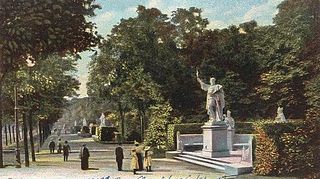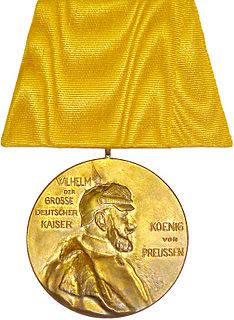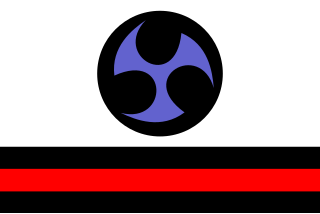
William I, or in German Wilhelm I., of the House of Hohenzollern, was King of Prussia from 2 January 1861 and the first German Emperor from 18 January 1871 to his death, the first head of state of a united Germany. Under the leadership of William and his Minister President Otto von Bismarck, Prussia achieved the unification of Germany and the establishment of the German Empire. Despite his long support of Bismarck as Minister President, William held strong reservations about some of Bismarck's more reactionary policies, including his anti-Catholicism and tough handling of subordinates. In contrast to the domineering Bismarck, William was described as polite, gentlemanly and, while staunchly conservative, he was more open to certain classical liberal ideas than his grandson Wilhelm II.

Johann Ludwig Tieck was a German poet, fiction writer, translator, and critic. He was one of the founding fathers of the Romantic movement in the late 18th and early 19th centuries.

The Treaty of Basel of 22 September 1499 was an armistice following the Battle of Dornach, concluding the Swabian War, fought between the Swabian League and the Old Swiss Confederacy.

The Siegesallee was a broad boulevard in Berlin, Germany. In 1895, Kaiser Wilhelm II ordered and financed the construction and expansion of an existing alley with a variety of marble statues, which was finalized in 1901.

Miyakojima is a city jurisdiction located on several islands in Okinawa Prefecture, Japan.
John C. G. Röhl is a British historian.

Wilhelm Lübke was a German art historian, born in Dortmund.
Gottfried Freiherr von Droste (1908–1992), a.k.a. Gottfried Freiherr von Droste zu Vischering-Padberg, was a German physical chemist. He worked at the Kaiser Wilhelm Institute for Chemistry (KWIC). He independently predicted that nuclear fission would release a large amount of energy. During World War II, he participated in the German nuclear energy project, also known as the Uranverein. In the latter years of the war, he worked at the Reich’s University of Strassburg. After the war, he worked at the Physikalisch-Technische Bundesanstalt (Federal Physical and Technical Institute and also held a position at the Technical University of Braunschweig.

The Wilhelmine Period comprises the period of German history between 1890 and 1918, embracing the reign of Emperor Wilhelm II in the German Empire from the resignation of Chancellor Otto von Bismarck until the end of World War I and Wilhelm's abdication during the November Revolution. It roughly coincided with the Belle Époque era of Western Europe.

A large number of monuments were erected in Germany in honour of Emperor William I. As early as 1867 the Berlin sculptor, Friedrich Drake, had created the first equestrian statue, that portrayed William I as the King of Prussia. To date the Prussian Monument Institute has recorded:
Axel Eugen Alexander von Oesterreich, better known as Axel von Ambesser, was a German actor and film director.

Wilhelm von Rümann was a prominent German sculptor, based in Munich.

The Kaiser Wilhelm Memorial Medal also known as the Centenary Medal was established on March 22, 1897 by Wilhelm II on the occasion of the 100th Birthday of his grandfather, Emperor Wilhelm I.

The Diederichs's stone was a German monument in the city of Qingdao to commemorate Admiral Otto von Diederichs and the German occupation of the Kiautschou Bay concession on November 14, 1897. The monument was dedicated on November 21, 1898 by Prince Henry of Prussia. It was located at an elevation of 98m, about halfway up the southwestern slope of the Signal Hill, the official German name of the mountain at the time was "Diederichsberg". Its most prominent feature was a plate decorated with the imperial eagle of the German Empire and the inscription "For him who won for Kaiser and Reich the land all around, let this rock be named Diederichs's stone". Below the plate was a rock inscription that read "In this place on November 14th, 1897, Admiral v.[von] Diederichs took possession of the Kiautschou territory". A separate Chinese inscription was located to the right-hand side of the German text. The entire monument stood about 5 meters tall. After Japan occupied Qingdao in November 1914, a Japanese inscription was placed across the imperial eagle. When Japan handed Qingdao back to the China on December 10, 1922, the monument was dismantled and parts taken to a military museum in Tokyo.

Max Unger was a German sculptor.

Toin Gakuen Schule Deutschland was a Japanese international school in Bad Saulgau, Baden-Württemberg, Germany. It opened since many Japanese company employees assigned to work in Germany wanted their children to be prepared for the Japanese school system when they return to Japan. The school had both junior and senior high school sections. Since it was an affiliate of Toin Gakuen (学校法人桐蔭学園), this school was an overseas branch of a Japanese private school, or a Shiritsu zaigai kyoiku shisetsu (私立在外教育施設). The school provided boarding facilities for its students.

Richard Heinzel was an Austrian medievalist, specializing in Germanic language and literature.

Philipp Wasserburg was a German Roman Catholic writer, publicist and member of the parliament of Hesse. He wrote under the pseudonym Philipp Laicus.

The proclamation of the German Empire, also known as the Deutsche Reichsgründung, took place in January 1871 after the joint victory of the German states in the Franco-Prussian War. As a result of the November Treaties of 1870s, the southern German states of Baden, Hesse-Darmstadt, with their territories south of the Main line, Württemberg and Bavaria, joined the Prussian-dominated "German Confederation" on 1 January 1871. On the same day, the new Constitution of the German Confederation came into force, thereby significantly extending the federal German lands to the newly created German Empire. The Day of the founding of the German Empire, January 18, became a day of celebration, marking when the Prussian King William I was proclaimed German Emperor in Versailles.



















